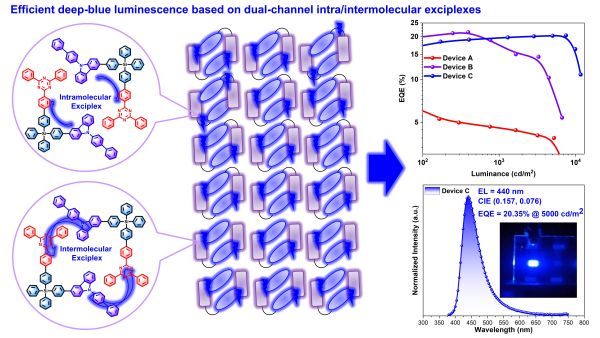Organic light-emitting diodes, OLEDs for short, are energy-efficient and flexible. However, it is still difficult to produce blue OLEDs. They have lacked luminance and stability so far. Researchers from Karlsruhe Institute of Technology (KIT) and Shanghai University have now developed a new strategy for the production of efficient deep-blue OLEDs: Electronic excitation of a specially developed new molecule results in a dual-channel intra-/intermolecular exciplex emission and, hence, deep-blue electroluminescence. The researchers report in Science Advances.
(DOI: 10.1126/sciadv.adf4060)
Organic light-emitting diodes are used in smart phones, tablets, and large TV screens. As they do not need any additional background illumination, they are energy-efficient. The can be produced at low costs by thin-film technology and also work on flexible carrier materials, thus enabling bendable displays and variable room illumination solutions. An OLED consists of two electrodes, of which at least one is transparent. Thin layers of organic semiconducting materials are located between them. Their light results from electroluminescence. When applying an electrical field, electrons from the cathode and holes (positive charges) from the anode are injected into the organic materials that act as emitters. There, electrons and holes meet and form electron-hole pairs. When these pairs collapse into their initial state again, they release energy that is used by the organic materials to emit light. All colors can be obtained by mixing blue, green, and red.
Why Blue Is Difficult
So far, phosphorescent OLEDs in red and green have been available for commercial applications only. Blue light can be produced by fluorescent OLEDs for a short time only. Blue OLEDs have difficulties to combine a high efficiency with a high luminescence and a long service life. Blue pixels are fainter or faint more quickly than green and red pixels. In cooperation with researchers from Shanghai University, researchers from KIT’s Institute of Organic Chemistry (IOC) and Institute of Biology and Chemical Systems – Functional Molecular Systems (IBCS-FMS) have now developed a new strategy for the production of highly efficient and stable deep-blue organic light-emitting diodes.
The researchers produced a new type of molecule, in which carbazole and triazine fragments are linked by a silicon atom (CzSiTrz). When the molecules assemble to form nanoparticles, electronic excitation causes intramolecular charge transfer emission and intermolecular exciplex luminescence, resulting in a dual-channel intra-/intermolecular exciplex emission. An exciplex is an electronically excited molecule complex. Its emission differs from the emissions of excited single molecules. “The exciplex strategy allows to achieve deep-blue electroluminescence, because the energy levels of the electron-donating carbazole fragments and electron-accepting triazine fragments can be adjusted independently of each other,” says Professor Stefan Bräse from IOC and IBCS-FMS.

(Graphics: Zhen Zhang)
New OLEDs Reach a High External Quantum Efficiency and High Luminance
The team succeeded in producing deep-blue OLEDs with a record-setting external quantum efficiency of 20.35 percent. The external quantum efficiency is the ratio between the radiation output and power input. Moreover, these OLEDs reach a high luminance of 5000 candela per square meter (cd/m2). The perceivable blue has the coordinates of 0.157/0.076 on the chromaticity diagram of the International Commission on Illumination (CIE). “Easy synthesis of the molecule and production of the components pave the way for a new generation of efficient and long-lived deep-blue OLEDs,” Bräse points out.
Original Publication (Open Access)
Zhen Zhang, Dehai Dou, Rongrong Xia, Peng Wu, Eduard Spuling, Ke Wang, Jin Cao, Bin Wei, Xifeng Li, Jianhua Zhang, Stefan Bräse, and Zixing Wang: Efficient deep-blue luminescence based on dual-channel intra/intermolecular exciplexes. Science Advances, 2023. DOI: 10.1126/sciadv.adf4060
https://www.science.org/doi/10.1126/sciadv.adf4060
More about the KIT Materials Center
In close partnership with society, KIT develops solutions for urgent challenges – from climate change, energy transition and sustainable use of natural resources to artificial intelligence, sovereignty and an aging population. As The University in the Helmholtz Association, KIT unites scientific excellence from insight to application-driven research under one roof – and is thus in a unique position to drive this transformation. As a University of Excellence, KIT offers its more than 10,000 employees and 22,800 students outstanding opportunities to shape a sustainable and resilient future. KIT – Science for Impact.

